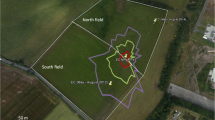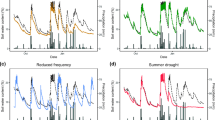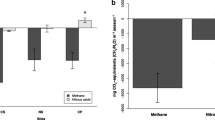Abstract
Despite increasing interest in the patterns of trace gas emissions in terrestrial ecosystems, little is known about the impacts of climate change on nitrous oxide (N2O) fluxes. The aim of this study was to determine the importance of the three main drivers of climate change (warming, summer drought, and elevated CO2 concentrations) on N2O fluxes from an extensively managed, upland grassland. Over a 2-year period, we monitored N2O fluxes in an in situ ecosystem manipulation experiment simulating the climate predicted for the study area in 2080 (3.5°C temperature increase, 20% reduction in summer rainfall and atmospheric CO2 levels of 600 ppm). N2O fluxes showed significant seasonal and interannual variation irrespective of climate treatment, and were higher in summer and autumn compared with winter and spring. Overall, N2O emissions showed a positive correlation with soil temperature and rainfall. Elevated temperature had a positive impact on mean annual N2O fluxes but effects were only significant in 2007. Contrary to expectations, neither combined summer drought and warming nor the simultaneous application of elevated atmospheric CO2 concentrations, summer drought and warming had any significant effect on annual N2O fluxes. However, the maximum N2O flux rates observed during the study occurred when elevated CO2 was combined with warming and drought, suggesting the potential for important, short-term N2O–N losses in enriched CO2 environments. Taken together, our results suggest that the N2O responses of temperate, extensively managed grasslands to future climate change scenarios may be primarily driven by temperature effects.




Similar content being viewed by others
References
Almaraz JJ, Zhou X, Mabood F, Madramootoo C, Rochette P, Ma BL, Smith DL. 2009. Greenhouse gas fluxes associated with soybean production under two tillage systems in southwestern Quebec. Soil Tillage Res 104:134–9.
Baggs EM, Richter M, Hartwig UA, Cadisch G. 2003. Nitrous oxide emissions from grass swards during the eighth year of elevated atmospheric pCO2 (Swiss FACE). Glob Chang Biol 9:1214–22.
Bateman EJ, Baggs EM. 2005. Contributions of nitrification and denitrification to N2O emissions from soils at different water-filled pore space. Biol Fertil Soils 41:379–88.
Billings SA, Schaeffer SM, Zitze S, Charlet T, Smith SD, Evans RD. 2002. Alterations of nitrogen dynamics under elevated carbon dioxide in an intact Mojave Desert ecosystem: evidence from nitrogen-15 natural abundance. Oecologia 131:463–7.
Bloor JMG, Niboyet A, Leadley PW, Barthes L. 2009. CO2 and inorganic N supply modify competition for N between co-occurring grass plants, tree seedlings and soil microorganisms. Soil Biol Biochem 41:544–52.
Bloor JMG, Pichon P, Falcimagne R, Leadley P, Soussana JF. 2010. Effects of warming, summer drought and CO2 enrichment on aboveground biomass production, flowering phenology and community structure in an upland grassland ecosystem. Ecosystems 13:888–900.
Bremner JM. 1997. Sources of nitrous oxide in soils. Nutr Cycl Agroecosyst 49:7–16.
Chapuis-Lardy L, Wrage N, Métay A, Chotte JL, Bernoux M. 2007. Soils, a sink for N2O? A review. Glob Chang Biol 13:1–17.
Clayton H, Mc Taggart IP, Parker J, Sawn L, Smith KA. 1997. Nitrous oxide emissions from fertlised grassland: a 2-year of the effects of N fertiliser form and environmental conditions. Biol Fertil Soils 25:252–60.
Cleland EE, Chiariello NR, Loarie SR, Mooney HA, Field CB. 2006. Diverse responses of phenology to global changes in a grassland ecosystem. Proc Natl Acad Sci USA 103:13740–4.
de Klein CAM, van Logtestijn RSP. 1995. Denitrification in grassland soils in the Netherlands in relation to irrigation, N-application rate, soil water content and soil temperature. Soil Biol Biochem 28:231–7.
Dobbie KE, Smith KA. 2001. The effects of temperature, water filled pore space and land use on N2O emissions from an imperfectly drained gleysol. Eur J Soil Sci 52:667–73.
Dukes JS, Chiariello NR, Cleland EE, Moore LA, Shaw MR, Thayer S, Tobeck T, Mooney HA, Field CB. 2005. Responses of grassland production to single and multiple global environmental changes. PLoS Biol 3:e319.
Engel EC, Weltzin JF, Norby JN, Classen AT. 2009. Responses of an old-field plant community to interacting factors of elevated [CO2], warming, and soil moisture. J Plant Ecol 2:1–11.
Flechard CR, Neftel A, Jocher M, Ammann C, Fuhrer J. 2005. Bi-directional soil/atmosphere N2O exchange over two mown grassland systems with contrasting management practices. Glob Chang Biol 11:2114–27.
Flechard CR, Ambus P, Skiba U, Rees RM, Hensen A, van Amstel A, van den Pol-van Dasselaar A, Soussana JF, Jones M, Clifton-Brown J, Raschi A, Horvath L, Neftel A, Jocher M, Ammann C, Leifeld J, Fuhrer J, Calanca P, Thalman E, Pilegaard K, DiMarco C, Campbell C, Nemitz E, Hargreaves KJ, Levy PE, Ball BC, Jones SK, van de Bulk WCM, Groot T, Blom M, Domingues R, Kasper G, Allard V, Ceschia E, Cellier P, Laville P, Henault C, Bizouard F, Abdalla M, Williams M, Baronti S, Berretti F, Grosz B. 2007. Effects of climate and management intensity on nitrous oxide emissions in grassland systems across Europe. Agric Ecosyst Environ 121:135–52.
Goossens A, De Visscher A, Boeckx P, van Cleemput O. 2001. Two-year field study on the emission of N2O from coarse and middle textured Belgian soils with different land use. Nutr Cycl Agroecosyst 60:23–34.
Granli T, Bøckmann OC. 1994. Nitrous oxide from agriculture. Norwegian J Agric Sci 12:1–128.
Hénault C, Bizouard F, Laville P, Gabrielle B, Nicoullaud B, Germon JC, Cellier P. 2005. Predicting in situ soil N2O emission using NOE algorithm and soil database. Glob Chang Biol 11:115–27.
Hernandez-Ramirez G, Brouder SM, Smith DR, Van Scoyoc GE. 2007. Greenhouse gas fluxes in an eastern corn belt soil: weather, nitrogen source, and rotation. J Environ Qual 38:841–54.
Hu S, Wu J, Burkey KO, Firestone MK. 2005. Plant and microbial N acquisition under elevated CO2 in two mesocosm experiments with annual grasses. Glob Chang Biol 11:213–23.
Hu Y, Chang X, Lin X, Wang Y, Wang S, Duan J, Zhang Z, Yang X, Luo C, Xu G, Zhao X. 2010. Effects of warming and grazing on N2O fluxes in an alpine meadow ecosystem on the Tibetan plateau. Soil Biol Biochem 42:944–52.
Hungate BA, Dukes JS, Shaw MR, Luo Y, Field CB. 2003. Nitrogen and climate change. Science 302:1512.
IPCC. 2001. In: McCarthy JJ, Canzani OF, Leary NA, Dokken DJ, White KS, Eds. Climate change 2001: contribution of the working group II to the third assessment report of the intergovernmental panel on climate change. Cambridge, United Kingdom, New York, NY, USA: Cambridge University Press. 1032 p.
IPCC. 2007. In: Solomon S, Qin D, Manning M, Chen Z, Marquis M, Averyt KB, Tignor M, Miller HL, Eds. Climate Change 2007: the physical science basis. Contribution of working group I to the fourth assessment report of the intergovernmental panel on climate change. Cambridge, United Kingdom, New York, NY, USA: Cambridge University Press. 996 p.
Jones SK, Rees RM, Skiba UM, Ball BC. 2005. Greenhouse gas emissions from a managed grassland. Glob Planet Change 47:201–11.
Kammann C, Grünhage L, Müller C, Jacobi S, Jäger HJ. 1998. Seasonal variability and mitigation options for N2O emissions from differently managed grasslands. Environ Pollut 102(S1):179–86.
Kammann C, Müller C, Grünhage L, Jäger HJ. 2008. Elevated CO2 stimulates N2O emissions in permanent grassland. Soil Biol Biochem 40:2194–205.
Kettunen R, Saarnio S, Martikainen PJ, Silvola J. 2005. Elevated CO2 concentration and nitrogen fertilisation effects on N2O and CH4 fluxes and biomass production of Phleum pratense on farmed peat soil. Soil Biol Biochem 37:739–50.
Kettunen R, Saarnio S, Martikainen PJ, Silvola J. 2007. Can a mixed stand of N2-fixing and non-fixing plants restrict N2O emissions with increasing CO2 concentration? Soil Biol Biochem 39:2538–46.
Loiseau P, Soussana JF. 2000. Effects of elevated CO2, temperature and N fertilization on nitrogen fluxes in a temperate grassland ecosystem. Glob Chang Biol 6:953–65.
Luo Y, Mooney HA, Eds. 1999. Carbon dioxide and environmental stress. San Diego: Academic Press San Diego.
Marriott CA, Hood K, Fischer JM, Pakeman RJ. 2009. Long-term impacts of extensive grazing and abandonment on the species composition, richness, diversity and productivity of agricultural grassland. Agric Ecosyst Environ 134:190–200.
Muhr J, Goldberg SD, Borken W, Gebauer G. 2008. Repeated drying–rewetting cycles and their effects on the emission of CO2, N2O, NOx and CH4 in a forest soil. J Plant Nutr Soil Sci 171:719–28.
Niklaus PA, Wardle DA, Tate KR. 2006. Effects of plant species diversity and composition on nitrogen cycling and the trace gas balance of soils. Plant Soil 282:83–98.
Osborne J. 2002. Notes on the use of data transformations. Pract Assess Res Eval 8(6).
Ravishankara AR, Daniel JS, Portmann RW. 2009. Nitrous Oxide (N2O): the dominant ozone-depleting substance emitted in the 21st century. Science 326:123–5.
Riedo M, Gyalistras D, Fuhrer J. 2000. Net primary and carbon stocks in differently managed grasslands: simulation of site-specific sensitivity to an increase in atmospheric CO2 and to climate change. Ecol Modell 134:207–27.
Ryden JC. 1981. N2O exchange between a grassland soil and the atmosphere. Nature 292:235–7.
Schrier-Uijl AP, Kroon PS, Hensen A, Leffelaar PA, Berendse F, Veeneedaal EM. 2010. Comparison of chamber and eddy-covariance-based CO2 and CH4 emission estimates in a heterogeneous grass ecosystem on peat. Agric For Meteorol 150:825–31.
Shu S, Lee E, Lee J. 2009. Temperature and moisture sensitivities of CO2 efflux from lowland and alpine meadow soils. J Plant Ecol 2:225–31.
Smith KA, Thomson PE, Clayton H, McTaggart IP, Conen F. 1998. Effects of temperature, water content and nitrogen, fertilisation on emissions of nitrous oxide by soils. Atmos Environ 32:3301–9.
Smith KA, Ball T, Conen F, Dobbie KE, Massheder J, Rey A. 2003. Exchange of greenhouse gases between soil and atmosphere: interactions of soil physical factors and biological processes. Eur J Soil Sci 56:779–91.
Wrage N, Velthof GL, van Beusichem ML, Oenema O. 2001. Role of nitrifier denitrification in the production of nitrous oxide. Soil Biol Biochem 33:12–13.
Wrage N, Lauf J, del Prado A. 2004. Distinguishing sources of N2O in European grasslands by stable isotope analysis. Rapid Commun Mass Spectrom 18:1201–7.
Yamulki S, Harrison RM, Goulding KWT, Webster CP. 1997. N2O, NO and NO2 fluxes from a grassland: effect of soil pH. Soil Biol Biochem 29:1199–208.
Zak DR, Pregitzer KS, King JS, Holmes WE. 2000. Elevated atmospheric CO2, fine roots and the response of soil microorganisms: a review and hypothesis. New Phytol 140:201–22.
Zar JH. 1998. Biostatistical analysis. 4th edn. Upper Saddle River, NJ: Prentice Hall. p 663.
Zavaleta ES, Shaw MR, Chiariello NR, Mooney HA, Field CB. 2003. Additive effects of simulated climate changes elevated CO2 and nitrogen deposition on grassland diversity. Proc Natl Acad Sci USA 100:7650–4.
Acknowledgments
Thanks to Patrick Pichon and Antoine Tardif for assistance with data collection and chamber measurements, to Robert Falcimagne for maintenance at the mini-FACE site and to Jeremy André for statistical help. The authors acknowledge the financial support of the French Ministry of Education and Research for the doctoral fellowship to AAMC and of the EC FP6 ‘NitroEurope-IP’ project.
Author information
Authors and Affiliations
Corresponding author
Additional information
Author Contributions
AAMC and ND conducted fieldwork; AAMC and JMGB wrote the manuscript; JMGB oversaw the study; JFS obtained funding for the experiment.
Electronic supplementary material
Below is the link to the electronic supplementary material.
10021_2010_9405_MOESM1_ESM.tif
Seasonal Averages of Daily Air Temperature Recorded during the Present Study for the Control Site Compared with the Elevated Temperature Site. Means and standard errors are presented (n = 90) (TIFF 89 kb)
10021_2010_9405_MOESM2_ESM.docx
Seasonal averages of soil moisture (WFPS, %) recorded during the N2O campaign measurements for experimental climate treatments. Means and standard errors are presented (n = 20-30) (DOCX 16 kb)
Rights and permissions
About this article
Cite this article
Cantarel, A.A.M., Bloor, J.M.G., Deltroy, N. et al. Effects of Climate Change Drivers on Nitrous Oxide Fluxes in an Upland Temperate Grassland. Ecosystems 14, 223–233 (2011). https://doi.org/10.1007/s10021-010-9405-7
Received:
Accepted:
Published:
Issue Date:
DOI: https://doi.org/10.1007/s10021-010-9405-7




